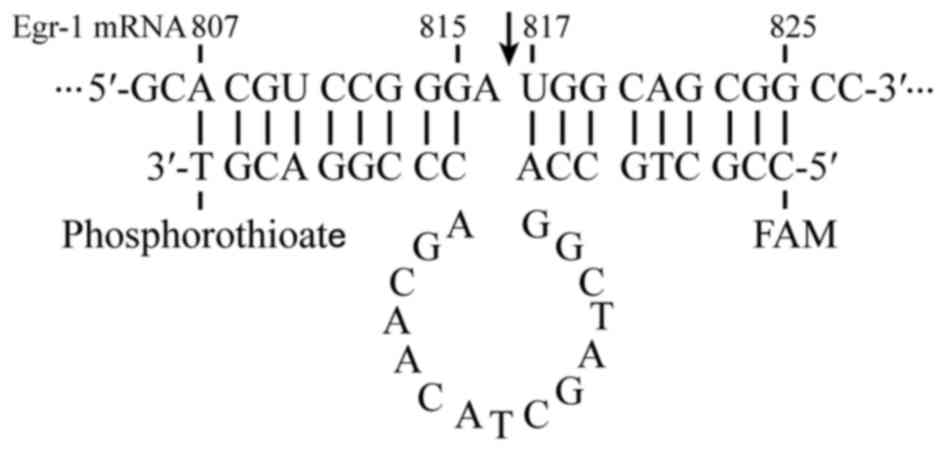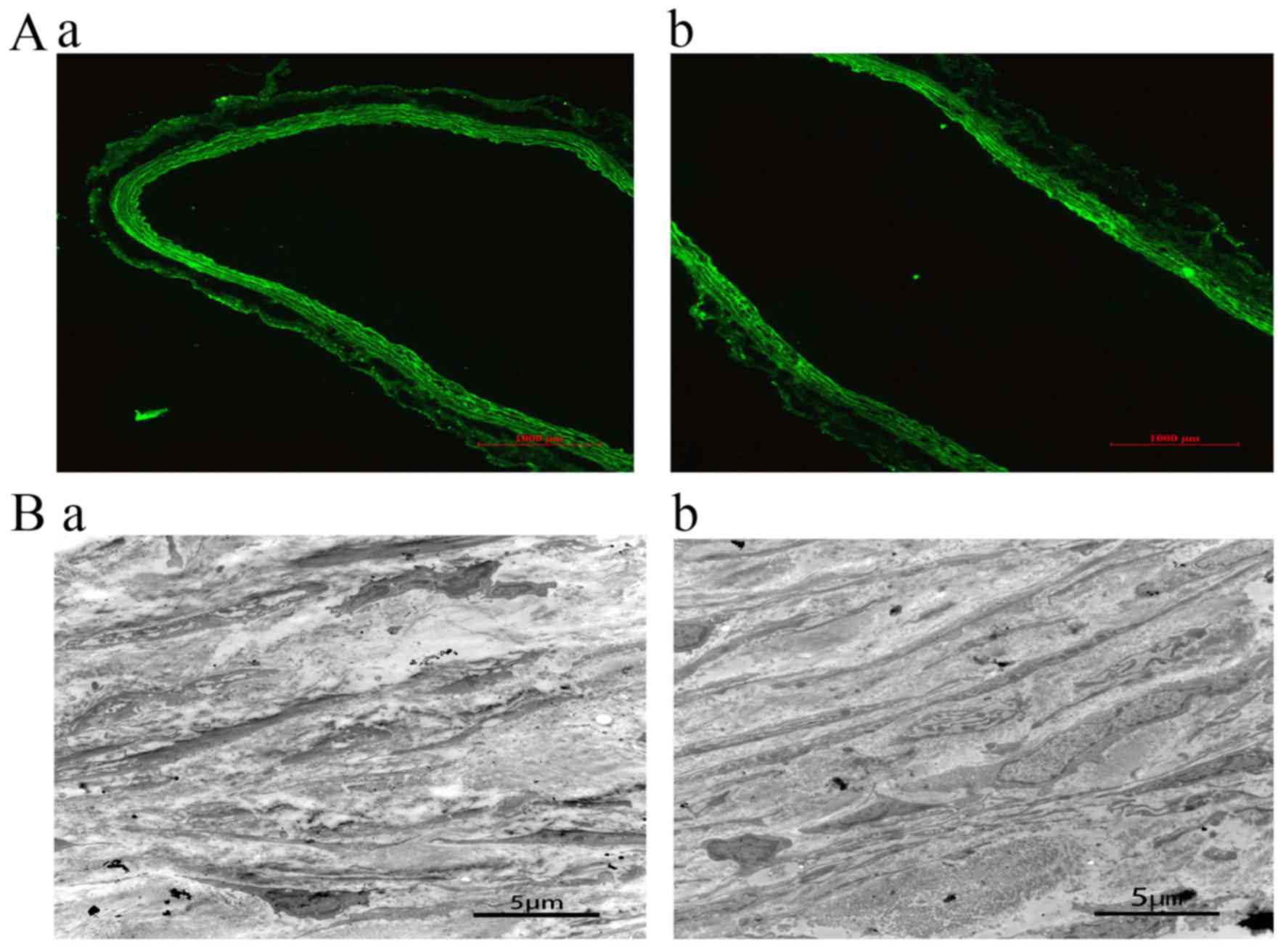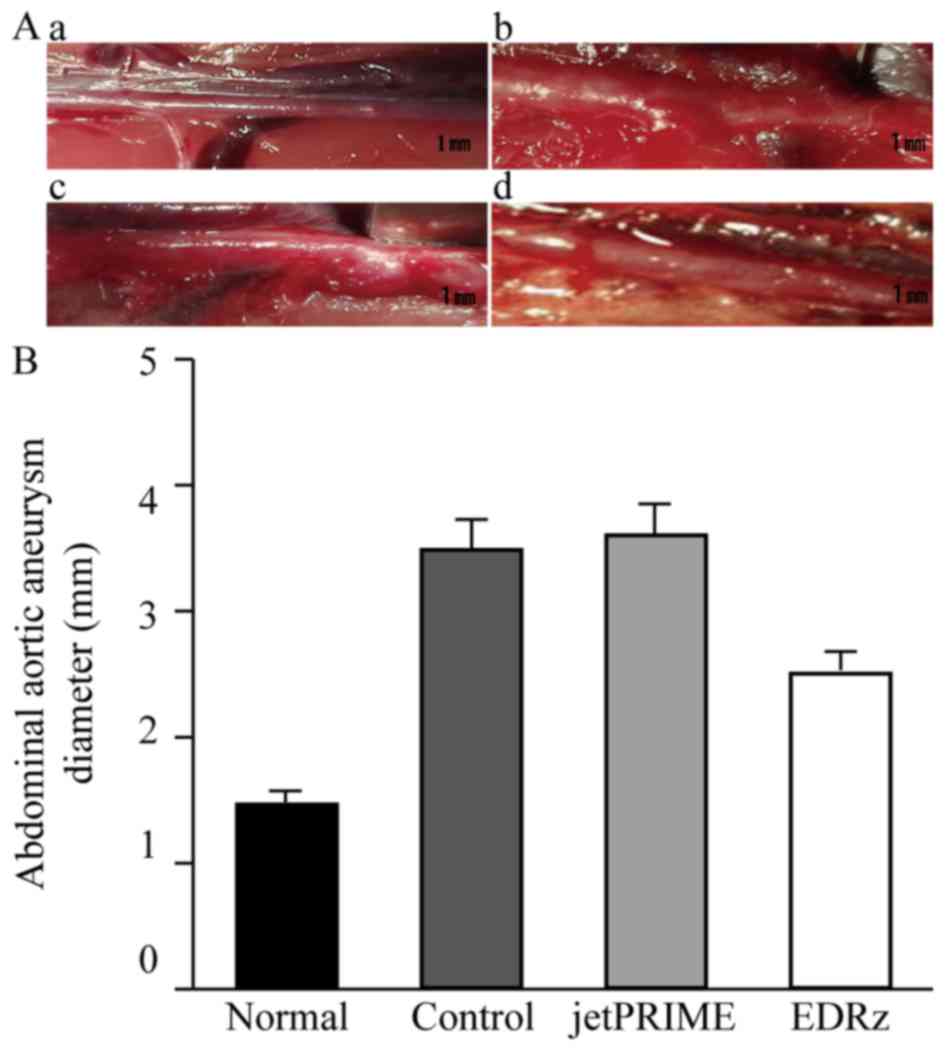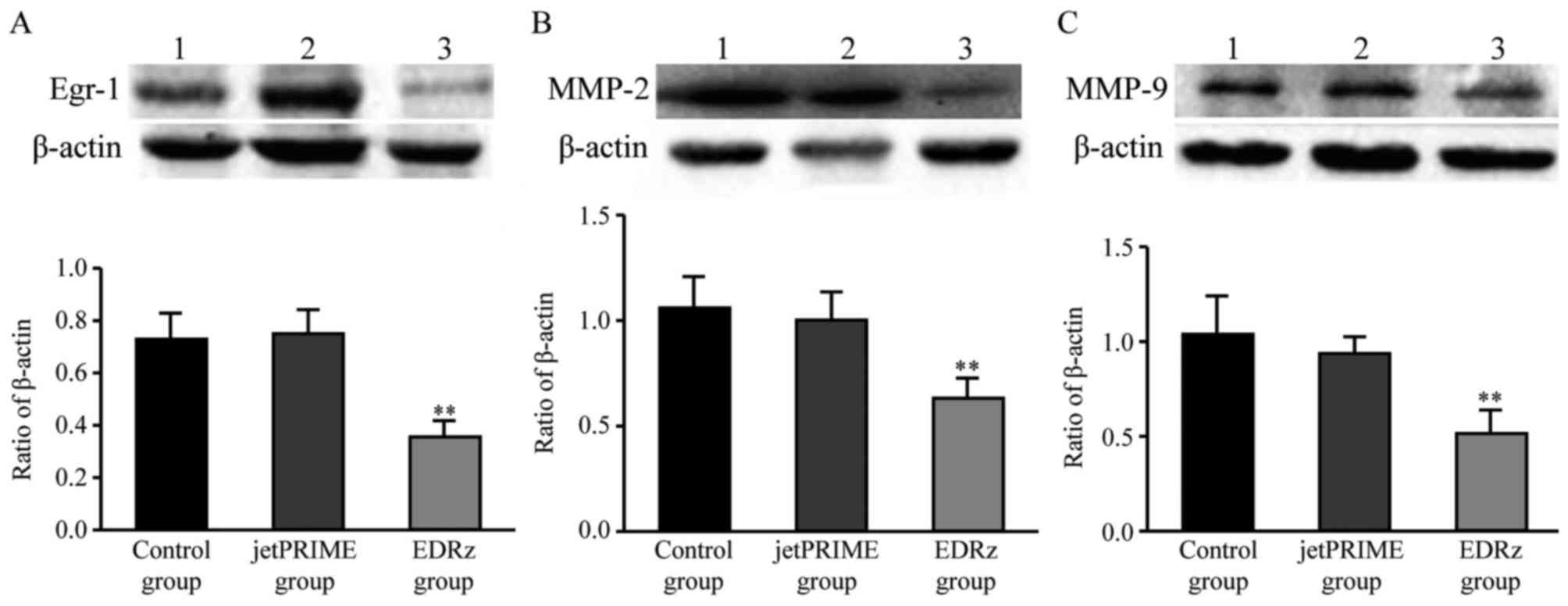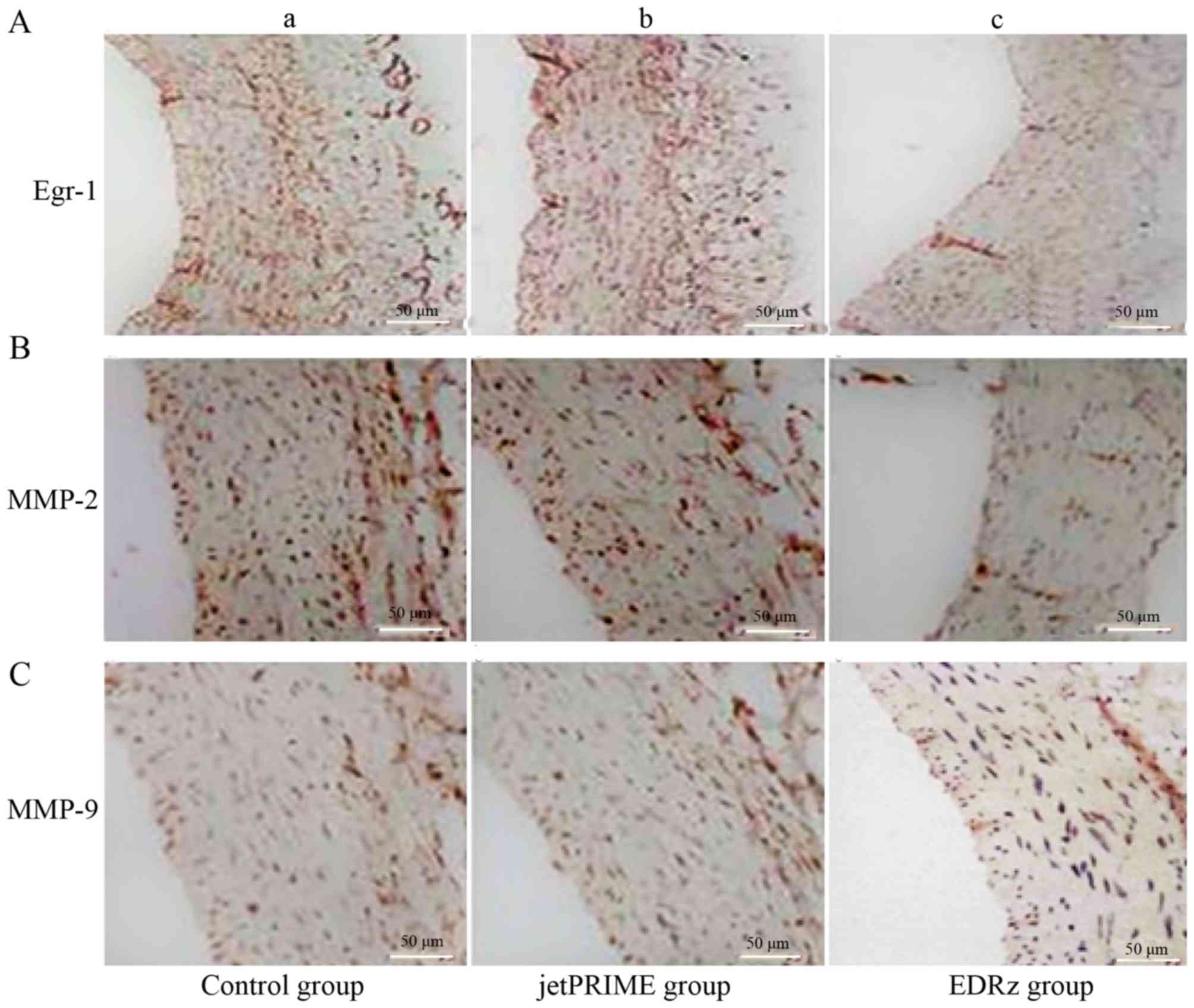|
1
|
Grøndal N, Søgaard R and Lindholt JS:
Baseline prevalence of abdominal aortic aneurysm, peripheral
arterial disease and hypertension in men aged 65–74 years from a
population screening study (VIVA trial). Br J Surg. 102:902–906.
2015. View
Article : Google Scholar : PubMed/NCBI
|
|
2
|
Benson RA, Poole R, Murray S, Moxey P and
Loftus IM: Screening results from a large United Kingdom abdominal
aortic aneurysm screening center in the context of optimizing
United Kingdom national abdominal aortic aneurysm screening
programme protocols. J Vasc Surg. 63:301–304. 2016. View Article : Google Scholar : PubMed/NCBI
|
|
3
|
Shin S, Cho YP, Jun H, Park H, Hong HN and
Kwon TW: Transglutaminase type 2 in human abdominal aortic aneurysm
is a potential factor in the stabilization of extracellular matrix.
J Vasc Surg. 57:1362–1370. 2013. View Article : Google Scholar : PubMed/NCBI
|
|
4
|
Tang L, Cong Z, Hao S, Li P, Huang H, Shen
Y, Li K and Jing H: Protective effect of melatonin on the
development of abdominal aortic aneurysm in a rat model. J Surg
Res. 209:266–278.e1. 2017. View Article : Google Scholar : PubMed/NCBI
|
|
5
|
Pagel JI and Deindl E: Early growth
response 1-a transcription factor in the crossfire of signal
transduction cascades. Indian J Biochem Biophys. 48:226–235.
2011.PubMed/NCBI
|
|
6
|
Wang NP, Pang XF, Zhang LH, Tootle S,
Harmouche S and Zhao ZQ: Attenuation of inflammatory response and
reduction in infarct size by postconditioning are associated with
downregulation of early growth response 1 during reperfusion in rat
heart. Shock. 41:346–354. 2014. View Article : Google Scholar : PubMed/NCBI
|
|
7
|
Liu C, Zhang X, Wang S, Cheng M, Liu C,
Wang S, Hu X and Zhang Q: Transfected early growth response gene-1
DNA enzyme prevents stenosis and occlusion of autogenous vein graft
in vivo. Biomed Res Int. 2013:3104062013.PubMed/NCBI
|
|
8
|
Ha YM, Lee DH, Kim M and Kang YJ: High
glucose induces connective tissue growth factor expression and
extracellular matrix accumulation in rat aorta vascular smooth
muscle cells via extracellular signal-regulated kinase 1/2. Korean
J Physiol Pharmacol. 17:307–314. 2013. View Article : Google Scholar : PubMed/NCBI
|
|
9
|
Charolidi N, Pirianov G, Torsney E, Pearce
S, Laing K, Nohturfft A and Cockerill GW: Pioglitazone identifies a
new target for aneurysm treatment: Role of Egr1 in an experimental
murine model of aortic aneurysm. J Vasc Res. 52:81–93. 2015.
View Article : Google Scholar : PubMed/NCBI
|
|
10
|
Shin IS, Kim JM, Kim KL, Jang SY, Jeon ES,
Choi SH, Kim DK, Suh W and Kim YW: Early growth response factor-1
is associated with intraluminal thrombus formation in human
abdominal aortic aneurysm. J Am Coll Cardiol. 53:792–799. 2009.
View Article : Google Scholar : PubMed/NCBI
|
|
11
|
Yamashiro Y, Papke CL, Kim J, Ringuette
LJ, Zhang QJ, Liu ZP, Mirzaei H, Wagenseil JE, Davis EC and
Yanagisawa H: Abnormal mechanosensing and cofilin activation
promote the progression of ascending aortic aneurysms in mice. Sci
Signal. 8:ra1052015. View Article : Google Scholar : PubMed/NCBI
|
|
12
|
Kong L, Shen X, Lin L, Leitges M, Rosario
R, Zou YS and Yan SF: PKCβ promotes vascular inflammation and
acceleration of atherosclerosis in diabetic ApoE null mice.
Arterioscler Thromb Vasc Biol. 33:1779–1787. 2013. View Article : Google Scholar : PubMed/NCBI
|
|
13
|
Morawietz H, Ma YH, Vives F, Wilson E,
Sukhatme VP, Holtz J and Ives HE: Rapid induction and translocation
of Egr-1 in response to mechanical strain in vascular smooth muscle
cells. Circ Res. 84:678–687. 1999. View Article : Google Scholar : PubMed/NCBI
|
|
14
|
Fu M, Zhu X, Zhang J, Liang J, Lin Y, Zhao
L, Ehrengruber MU and Chen YE: Egr-1 target genes in human
endothelial cells identified by microarray analysis. Gene.
315:33–41. 2003. View Article : Google Scholar : PubMed/NCBI
|
|
15
|
Yuan K, Liang W and Zhang J: A
comprehensive analysis of differentially expressed genes and
pathways in abdominal aortic aneurysm. Mol Med Rep. 12:2707–2714.
2015. View Article : Google Scholar : PubMed/NCBI
|
|
16
|
Li J, Wang N, Luo Q and Wan L: The 10–23
DNA enzyme generated by a novel expression vector mediate
inhibition of taco expression in macrophage. Oligonucleotides.
20:61–68. 2010. View Article : Google Scholar : PubMed/NCBI
|
|
17
|
Lam CH and Perrin DM: Introduction of
guanidinium-modified deoxyuridine into the substrate binding
regions of DNAzyme 10–23 to enhance target affinity: Implications
for DNAzyme design. Bioorg Med Chem Lett. 20:5119–5122. 2010.
View Article : Google Scholar : PubMed/NCBI
|
|
18
|
Pagel JI, Ziegelhoeffer T, Heil M, Fischer
S, Fernández B, Schaper W, Preissner KT and Deindl E: Role of early
growth response 1 in arteriogenesis: impact on vascular cell
proliferation and leukocyte recruitment in vivo. Thromb Haemost.
107:562–574. 2012. View Article : Google Scholar : PubMed/NCBI
|
|
19
|
Dickinson MG, Kowalski PS, Bartelds B,
Borgdorff MA, van der Feen D, Sietsma H, Molema G, Kamps JA and
Berger RM: A critical role for Egr-1 during vascular remodelling in
pulmonary arterial hypertension. Cardiovasc Res. 103:573–584. 2014.
View Article : Google Scholar : PubMed/NCBI
|
|
20
|
Huang M, Satchell L, Duhadaway JB,
Prendergast GC and Laury-Kleintop LD: RhoB links PDGF signaling to
cell migration by coordinating activation and localization of Cdc42
and Rac. J Cell Biochem. 112:1572–1584. 2011. View Article : Google Scholar : PubMed/NCBI
|
|
21
|
Uchida K, Sasahara M, Morigami N, Hazama F
and Kinoshita M: Expression of platelet-derived growth factor
B-chain in neointimal smooth muscle cells of balloon injured rabbit
femoral arteries. Atherosclerosis. 124:9–23. 1996. View Article : Google Scholar : PubMed/NCBI
|
|
22
|
Iyoda T, Zhang F, Sun L, Hao F,
Schmitz-Peiffer C, Xu X and Cui MZ: Lysophosphatidic acid induces
early growth response-1 (Egr-1) protein expression via protein
kinase Cδ-regulated extracellular signal-regulated kinase (ERK) and
c-Jun N-terminal kinase (JNK) activation in vascular smooth muscle
cells. J Biol Chem. 287:22635–22642. 2012. View Article : Google Scholar : PubMed/NCBI
|
|
23
|
Wu Y, Han W and Liu GN: A DNA enzyme
targeting Egr-1 inhibits rat vascular smooth muscle cell
proliferation by down-regulation of cyclin D1 and TGF-beta1. Braz J
Med Biol Res. 43:17–24. 2010. View Article : Google Scholar : PubMed/NCBI
|
|
24
|
Longo GM, Xiong W, Greiner TC, Zhao Y,
Fiotti N and Baxter BT: Matrix metalloproteinases 2 and 9 work in
concert to produce aortic aneurysms. J Clin Invest. 110:625–632.
2002. View Article : Google Scholar : PubMed/NCBI
|
|
25
|
Yan YF, Pei JF, Zhang Y, Zhang R, Wang F,
Gao P, Zhang ZQ, Wang TT, She ZG, Chen HZ and Liu DP: The
paraoxonase gene cluster protects against abdominal aortic aneurysm
formation. Arterioscler Thromb Vasc Biol. 37:291–300. 2017.
View Article : Google Scholar : PubMed/NCBI
|
|
26
|
Chabasse C, Siefert SA, Chaudry M,
Hoofnagle MH, Lal BK and Sarkar R: Recanalization and flow regulate
venous thrombus resolution and matrix metalloproteinase expression
in vivo. J Vasc Surg Venous Lymphat Disord. 3:64–74. 2015.
View Article : Google Scholar : PubMed/NCBI
|
|
27
|
Tanaka A, Hasegawa T, Chen Z, Okita Y and
Okada K: A novel rat model of abdominal aortic aneurysm using a
combination of intraluminal elastase infusion and extraluminal
calcium chloride exposure. J Vasc Surg. 50:1423–1432. 2009.
View Article : Google Scholar : PubMed/NCBI
|
|
28
|
Pezet M, Jacob MP, Escoubet B, Gheduzzi D,
Tillet E, Perret P, Huber P, Quaglino D, Vranckx R, Li DY, et al:
Elastin haploinsufficiency induces alternative aging processes in
the aorta. Rejuvenation Res. 11:97–112. 2008. View Article : Google Scholar : PubMed/NCBI
|
|
29
|
Shin SY, Kim JH, Baker A, Lim Y and Lee
YH: Transcription factor Egr-1 is essential for maximal matrix
metalloproteinase-9 transcription by tumor necrosis factor alpha.
Mol Cancer Res. 8:507–519. 2010. View Article : Google Scholar : PubMed/NCBI
|
|
30
|
Harja E, Chang JS, Lu Y, Leitges M, Zou
YS, Schmidt AM and Yan SF: Mice deficient in PKCbeta and
apolipoprotein E display decreased atherosclerosis. FASEB J.
23:1081–1091. 2009. View Article : Google Scholar : PubMed/NCBI
|
|
31
|
Haas TL, Stitelman D, Davis SJ, Apte SS
and Madri JA: Egr-1 mediates extracellular matrix-driven
transcription of membrane type 1 matrix metalloproteinase in
endothelium. J Biol Chem. 274:22679–22685. 1999. View Article : Google Scholar : PubMed/NCBI
|
|
32
|
Sho E, Sho M, Singh TM, Nanjo H, Komatsu
M, Xu C, Masuda H and Zarins CK: Arterial enlargement in response
to high flow requires early expression of matrix metalloproteinases
to degrade extracellular matrix. Exp Mol Pathol. 73:142–153. 2002.
View Article : Google Scholar : PubMed/NCBI
|



